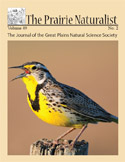Great Plains Natural Science Society

The Prairie Naturalist
Date of this Version
6-2011
Document Type
Article
Citation
The Prairie Naturalist 43(1/2):59–60; 2011
Abstract
The least weasel (Mustela nivalis) is a circumboreal species, occurring in North America from Alaska to the Appalachian Mountains (Jones et al. 1983). In the Great Plains, the least weasel recently expanded its range southward through Nebraska (Benedict et al. 2000) and Kansas (Choate et al. 1979, Bailey and Terman 1986) into Oklahoma (Clark and Clark 1988). Also, in recent decades, the least weasel has expanded from eastern and central Nebraska into western Nebraska (Benedict et al. 2000). In South Dakota, least weasels have been previously reported from the eastern 3/4 of the state (Jones et al. 1983, Higgins et al. 2000). Herein, I document the first record of the least weasel in the Black Hills of South Dakota, representing the western-most distributional record for the state.
On 7–8 July 2010, I captured two least weasels during a study of the distribution and abundance of the Bear Lodge meadow jumping mouse (Zapus hudsonius campestris). The study site was located 16.1 km southeast of Custer along an un-named creek paralleling Forest Service Road 336 in Custer County, South Dakota. This creek is a part of the headwaters of Beaver Creek, which flows southeast through Wind Cave National Park. On 6 July 2010, I set 100 folding Sherman Live Traps (7.6 8.9 23 cm) at 10- m intervals along four, 240-m transects. Two transects paralleled opposite sides of the creek and two ran perpendicular from the creek to the southwest. I baited the traps with a mixture of cracked corn, oats, wheat and molasses and checked them each morning for 3 consecutive days. All procedures were approved in advance by the Institutional Animal Care and Use Committee (IACUC) at Dakota Wesleyan University (approval no. 102). Voucher specimens were deposited in the Sternberg Museum of Natural History (MHP), Fort Hays State University, Hays, Kansas.
Included in
Biodiversity Commons, Botany Commons, Ecology and Evolutionary Biology Commons, Natural Resources and Conservation Commons, Systems Biology Commons, Weed Science Commons


Comments
Published by the Great Plains Natural Science Society. Used by permission.